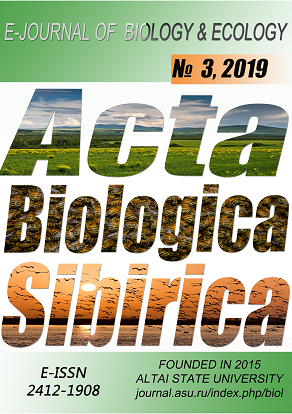Abstract
Wing pattern, male genitalia armatures and the COI-gene sequence within the checkerspots of the group Melitaea minerva are examined. The lectotypes of M. asteroida variegata and M. asteroida maculata are designated, it is shown that both taxa belong to M. minerva (subspecies of it), but not to M. asteroida. Basing on the DNA investigation (COI sequence) I made an assumption that the taxa M. minerva and M. pallas are conspecific. M. solona is not a separate species but forms a group of phenotypes characteristic for both M. minerva and M. asteroida. The male genitalia features are inapplicable for the species identification within the group M. minerva.
References
Churkin, S.V., Kolesnichenko, K.A., Tuzov, V.K. (2000). A review of the Melitaea asteroida species-group (Lepidoptera, Nymphalidae) with new taxa descriptions. Helios, 1, 61-87.
Higgins, L.G. (1941). An illustrated catalogue of the Palaearctic Melitaea (Lep. Rhopalocera). Transactions of the Royal Entomological Society of London, 91, 175-354. https://doi.org/10.1111/j.1365-2311.1941.tb01045.x
Kolesnichenko, K.A., Churkin, S.V. (2003). A review of the Melitaea minerva (Staudinger, 1881) species-group (Lepidoptera, Nymphalidae). Helios, 4, 301-341.
Korb, S.K. (2013). Butterflies (Lepidoptera: Papilionoformes) of North Tian-Shan. Part 2. Nymphalidae, Riodinidae, Lycaenidae. Eversmannia, Suppl. 4.
Korb, S.K. (2016). On the status of Melitaea ala kotshubeji Sheljuzhko, 1929, Melitaea didyma enarea Fruhstorfer, 1916 and Melitaea enarea gromenkoi Kolesnichenko, 1999 and the questions of the subspecies systematics inside of this group (Lepidoptera, Nymphalidae). Amurian zoological Journal, 8, 64-72.
Korb, S.K., Bolshakov, L.V. (2016). A systematic catalogue of butterflies of the former Soviet Union (Armenia, Azerbaijan, Belarus, Estonia, Georgia, Kyrgyzstan, Kazakhstan, Latvia, Lituania, Moldova, Russia, Tajikistan, Turkmenistan, Ukraine, Uzbekistan) with special account to their type specimens (Lepidoptera: Hesperioidea, Papilionoidea). Zootaxa, 4160, 324 p. https://doi.org/10.11646/zootaxa.4160.1.1
Korb, S.K., Fric, Z.F., Bartonova, A. (2017). On the status and position of Melitaea minerva var. palamedes Groum-Grshimaïlo, 1890 (Lepidoptera: Nymphalidae). SHILAP Revista de Lepidopterología, 45, 17-22.
Lambert, D.M., Baker, A., Huynen, L., Haddrath, O., Hebert, P.D.N., Millar, C.D. (2005). Is a largescale DNA-based inventory of ancient life possible? Journal of Heredity, 96, 279-284. https://doi.org/10.1093/jhered/esi035
Lukhtanov, V.A. (2017). A new species of Melitaea from Israel, with notes on taxonomy, cytogenetics, phylogeography and interspecific hybridization in the Melitaea persea complex (Lepidoptera, Nymphalidae). Comparative Cytogenetics, 11, 325-357.https://doi.org/10.3897/CompCytogen.v11i2.12370
Pazhenkova, E.A., Zakharov, E.V., Lukhtanov, V.A. (2015). DNA barcoding reveals twelve lineages with properties of phylogenetic and biological species within Melitaea didyma sensu lato (Lepidoptera, Nymphalidae). ZooKeys, 538, 35-46. https://doi.org/10.3897/zookeys.538.6605
Ratnasingham, S., Hebert, P.D.N. (2007). BOLD: The Barcode of Life Data System (www.barcodinglife.org). Molecular Ecology Notes, 7, 355-364.https://doi.org/10.1111/j.1471-8286.2007.01678.x
Van Oorschot, H., Coutsis, J.G. (2014). The genus Melitaea Fabricius, 1807 (Lepidoptera: Nymphalidae, Nymphalinae) Taxonomy and systematics with special reference to the male genitalia. Pardubice: Tshikolovets Publications.
Acta Biologica Sibirica is a golden publisher, as we allow self-archiving, but most importantly we are fully transparent about your rights.
Authors may present and discuss their findings ahead of publication: at biological or scientific conferences, on preprint servers, in public databases, and in blogs, wikis, tweets, and other informal communication channels.
ABS allows authors to deposit manuscripts (currently under review or those for intended submission to ABS) in non-commercial, pre-print servers such as ArXiv.
Authors who publish with this journal agree to the following terms:
- Authors retain copyright and grant the journal right of first publication with the work simultaneously licensed under a Creative Commons Attribution License (CC BY 4.0) that allows others to share the work with an acknowledgement of the work's authorship and initial publication in this journal.
- Authors are able to enter into separate, additional contractual arrangements for the non-exclusive distribution of the journal's published version of the work (e.g., post it to an institutional repository or publish it in a book), with an acknowledgement of its initial publication in this journal.
- Authors are permitted and encouraged to post their work online (e.g., in institutional repositories or on their website) prior to and during the submission process, as it can lead to productive exchanges, as well as earlier and greater citation of published work (See The Effect of Open Access).





